The Advent and Potential Impact of Ionic Liquid Stationary Phases in GC and GCxGC
LCGC North America
Guest columnists explore how ionic liquids can be tweaked to mimic the popular stationary phases of today.
Choices of available stationary phases for GC have been fairly constant for many years. The same basic types of columns that do analogous separations can be obtained from any of a large number of sources, worldwide. Recent research has indicated that unique new substances have been developed that will play an important role in GC column technology. These substances are ionic liquids (ILs). ILs are solvents in which the constituents consist entirely of ions. By definition, they are pure salts that have melting points below 100 °C. However, when used as GC stationary phases, melting points in the range of ~ –40 °C to 50 °C are preferable. ILs have a number of properties that make them exceptional stationary phases. For example, their viscosity can be varied over a broad range, they can have high thermal stabilities, they can be coated on fused-silica capillaries with high efficiencies, they have unique solvent properties, and they can be immobilized and crosslinked (1–7). Indeed, it was noted early on that IL stationary phases had a dual nature in that they separated nonpolar analytes as if they were nonpolar stationary phases and simultaneously separated polar analytes as if they were polar stationary phases (8).

Ronald E. Majors
Another very important aspect of IL stationary phases is that their physico-chemical properties are almost infinitely tunable. Tunability is a characteristic that is unavailable to all other classes of GC stationary phases. With relatively simple synthetic modifications or changes to an IL's cation, anion, the substituents thereon, and their linkage chains, one can alter and control whatever solvent and selectivity characteristics that are desired (9–11).
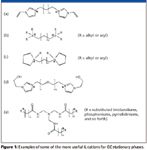
Figure 1
Types of ILs for GC Use
Figure 1 shows the structures of typical "tunable," high-stability cations that have been shown to be particularly useful as GC stationary phase components. Figure 2 shows the structure of two of the more common anions used in IL–GC formulations. The bis(trifluoromethane)sulfonamide anion (NTf2-) tends to produce ILs with lower melting points and somewhat lower polarities than the triflate anion (TfO-). Also, it provides excellent peak shapes for nonhydrogen bonding or weakly hydrogen bonding analytes, but tends to produce tailing peaks for alcohols, carboxylic acids, and amines. The tailing peaks of these strong hydrogen bonding analytes can be minimized or eliminated by masking the effect of the NTf2- anion by using a cation containing an amide moiety (see trigonal cation in Figure 1e) or by utilizing the triflate anion. Examples of these behaviors will be shown throughout this monograph. The cations (Figure 1) can be further selected and varied to emphasize or deemphasize any known solvation interactions including: n/π, dipolar, H-bond acidity, H-bond basicity, and dispersion interactions. Clearly, the hydrocarbon linkage chains (connecting the charged moieties) produce less polar stationary phases than polyethylene glycol types. Shorter linkage chains result in more polar stationary phases than analogous longer chains. Imidazolium cations have a delocalized positive charge in contrast to phosphonium and pyrrolidinium cations (Figures 1b and 1c). The NTf2- anion has a more delocalized charge and is more hydrophobic than the triflate anion.

Figure 2
While it is difficult to predict the future, it is clear that IL stationary phases will have a direct impact on specific areas of GC. Four representative areas are listed in Table I. Examples of IL-based separations involving each of these "impact areas" will be presented and discussed.
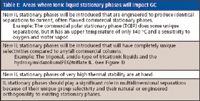
Table I: Areas where ionic liquid stationary phases will impact GC
Polar IL Stationary Phases with Low Bleed and High Thermal Stability
Polyethylene glycol (PEG) wax-type coatings are popular and ubiquitous polar stationary phases in GC. The "bleed temperature" can vary somewhat with the molecular weight of the polymers used, and possibly with the pretreatment procedures used on the fused-silica capillary. Typically, the upper temperature limits for these columns are in the 240–280 °C range, depending upon the manufacturer. Figure 3 shows a comparison of the thermal stability–bleed profiles between a typical PEG GC column and a phosphonium IL-based column of approximately the same polarity (see structure in Figure 1b). The "wax" stationary phase starts to show significant bleed at 280 °C and by 350 °C this stationary has been stripped completely from the fused-silica capillary. At the same temperature (350 °C), the phosphonium IL column is just beginning to have detectable bleed. Indeed the lower bleed of many IL columns and smaller, simpler fragmentation at high temperatures results in less interference and lower limits of detection for many GC–mass spectrometry (MS) applications. Figure 4 shows that there are minimal changes in the retention times of a rapeseed oil fatty acid methyl ester (FAME) mixture on the phosphonium IL column after 80 h of conditioning at 300 °C.
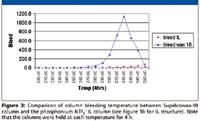
Figure 3
Polar IL Stationary Phase with Same Selectivity and Higher Stability
One of the most polar GC stationary phases available today is 1,2,3-tris(2-cyanoethoxy)propane (TCEP) (Figure 5). However, it has a maximum operating temperature of 140 °C and is moisture and oxygen sensitive. However, a divinylimidazolium NTf2- IL has been engineered to give the same selectivity (Figure 6), and it is both oxygen and moisture stable and has a thermal stability of ~240 °C. In addition, the IL column (SBIL-100, Supelco, Bellefonte, Pennsylvania) shows unique selectivities for many other types of compounds. Unique selectivity is shown by the differences in the retention order of PCB congeners on the IL column (Figure 7) versus a commercial cyanopropylpolysiloxane column (SP-2331, Supelco, Bellefonte, Pennsylvania). Also note the faster elution times on the IL column, observed for a different standard mixture versus the TCEP column (Figure 6).

Figure 4
IL Stationary Phases with New Selectivities
IL stationary phases also appear to have excellent selectivity for cis–trans isomers of FAMEs, as shown in Figure 8. Positional geometric FAME isomers typically are resolved using 100 m × 0.25 mm highly polar cyanosilicone stationary phases. Figure 8 shows that a 60 m × 0.25 mm SLB-IL100 column is capable of providing resolution of a number of the monoene, diene, and triene fractions of the C18 FAME isomers. Better resolution is seen of the triene compared with that provided by the longer cyanosilicone column (12).
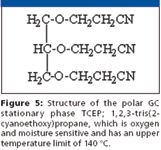
Figure 5
Perhaps the most polar IL stationary phases yet tested are based upon hydroxyimidazolium (PEG) triflate (Figure 1d). In addition to being highly polar and possessing unique selectivities, the triflate anion gives excellent peak shapes for analytes with strong hydrogen bonding groups (especially alcohols, diols, carboxylic acids, and amines). This feature is illustrated in Figures 9 and 10. A chromatogram for a mixture of n-alkanes and alcohols is shown in Figure 9. Note how much the hydrocarbons are shifted to lower retention values relative to the alcohols. Also note the excellent peak shapes for both groups of analytes on this relatively short 10-m column. The Grob mix is separated on the same 10-m column as shown in Figure 10. Because of the triflate anion, the acidic and basic analytes (peaks 6, 7, 11, and 12) have good peak shapes. Also note that peak 8 (methyl decanoate) is eluted before peaks 4 and 3 (that is, 1-octanol and 1-nonanal). This is quite unusual and is indicative of the high polarity of this IL stationary phase.
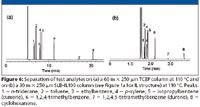
Figure 6
IL Stationary Phases for Comprehensive GC Applications
Given the unique characteristics of IL stationary phases, it is apparent that they will be quite useful for comprehensive multidimensional separations. Recent reports (13,14) involving GC×GC indicate that IL columns used in conjunction with conventional columns (in either the first or second dimension) show unique group selectivities. For example, when analyzing diesel fuel with GC×GC, the best group separation of saturated hydrocarbons versus monoaromatic versus diaromatic compounds was obtained when using a phosphonium NTf2- IL in the first dimension and a nonpolar HP-5 column in the second dimension (13).

Figure 7
In other work, a GC×GC separation (which utilized a divinylimidazolium triflate IL in the second dimension) was the only combination able to completely isolate analytes containing phosphorus–oxygen moieties from all other compounds (14). This type of group selectivity is particularly important when analyzing pesticides, nerve agents, and residues thereof. Tunable dual-column GC with a divinylimidazolium NTf2- stationary phase was used in conjunction with headspace sampling to characterize U.S. currency and other complex samples (15).

Figure 8
Figure 11 is a comparison of the GC×GC–TOF-MS profiles of a petroleum distillate using two different column sets (16). Figure 11b utilized a phosphonium NTf2- column in the second dimension rather than the conventional PEG–wax column (Figure 11a). As can be seen, the important toxic compound, diphenylmethane, is only resolved when using the IL column (Figure 11b). In addition, it appears that the group separations are more definitive in the column set that utilizes the IL stationary phase.
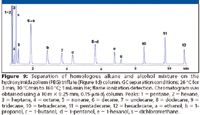
Figure 9
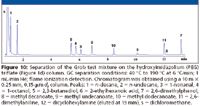
Figure 10
Conclusions
Undoubtedly, 2009 will be a "benchmark" year for ILs in GC. They will become widely available to both academic and industrial scientists for the first time. Although ILs will continue to be the focus of cutting-edge research in separation science in the foreseeable future, the current IL materials are about to be thoroughly examined and tested by the everyday users of GC. They will be doing things to and with these columns that were not the focus of academics. Through this coming harsh reality, we will learn considerably more about the uses and limitations of IL stationary phases. These lessons will then lead to another generation of ILs; because after all, they are almost infinitely tunable.
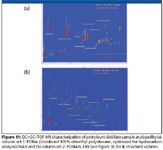
Figure 11
Ronald E. Majors "Column Watch" Editor Ronald E. Majors is business development manager, Consumables and Accessories Business Unit, Agilent Technologies, Wilmington, Delaware, and is a member of LCGC's editorial advisory board. Direct correspondence about this column to "Sample Prep Perspectives," LCGC, Woodbridge Corporate Plaza, 485 Route 1 South, Building F, First Floor, Iselin, NJ 08830, e-mail lcgcedit@lcgcmag.com.
Daniel W. Armstrong and Tharanga Payagala are with the Department of Chemistry and Biochemistry, University of Texas at Arlington, Arlington, Texas.
Leonard M. Sidisky is with Sigma-Aldrich-Supelco, Bellefonte, Pennsylvania.
References
(1) X. Han and D.W. Armstrong, Acc. Chem. Res. 40, 1079 (2007).
(2) J.L. Anderson and D.W. Armstrong, Anal. Chem. 77, 6453 (2005).
(3) K. Huang, X. Han, X. Zhang, and D.W. Armstrong, Anal. Bioanal. Chem. 389, 2265 (2007).
(4) Z.S. Bretibach and D.W. Armstrong, Anal. Bioanal. Chem., 390, 1605 (2008).
(5) T. Payagala, Y. Zhang, E. Wanigasekara, K. Huang, Z.S. Breitbach, P.S. Sharma, L.M. Sidisky, and D.W. Armstrong, Anal. Chem. 81, 160 (2009).
(6) J.L. Anderson and D.W. Armstrong, G.-T. Wei, Anal. Chem. 78, 2893 (2006).
(7) R.J. Soukup-Hein, M.M. Warnke, and D.W. Armstrong, Annu. Rev. Anal. Chem. 2, 8.1 (2009).
(8) D.W. Armstrong, L.F. He, and Y.S. Liu, Anal. Chem. 71, 3873 (1999).
(9) T. Payagala, J. Huang, Z.S. Breitbach, P.S. Sharma, and D.W. Armstrong, Chem. Mater. 19, 5848 (2007).
(10) J.L. Anderson, J. Ding, T. Welton, and D.W. Armstrong, J. Am. Chem. Soc. 124, 14247 (2002).
(11) J.L. Anderson, R. Ding, A. Ellern, and D.W. Armstrong, J. Am. Chem. Soc. 127, 593 (2005).
(12) C. Ragonese, P.Q. Tranchida, P. Dugo, G. Dugo, L.M. Sidisky, M.V. Robillard, and L. Mondello, Anal. Chem., in press (2009).
(13) J.V. Seeley, S.K. Seeley, E.K. Libby, Z.S. Breitbach, and D.W. Armstrong, Anal. Bioanal. Chem. 390, 323 (2008).
(14) V.R. Reid, J.A. Crank, D.W. Armstrong, and R.E. Synovec, J. Sep. Sci. 31, 3429 (2008).
(15) G.R. Lambertus, J.A.Crank, M.E. McGuigan, S. Kendler, D.W. Armstrong, and R.D. Sacks, J. Chromatogr., A. 1135, 230 (2006).
(16) J.-M.D. Dimandja, H.A. Pham, H. Wang, W.E. Rathbun, P.P. Adams, and D.W. Armstrong, Pittcon 2009 Technical Program, poster 1980-26P, March 11, 2009

New Study Reviews Chromatography Methods for Flavonoid Analysis
April 21st 2025Flavonoids are widely used metabolites that carry out various functions in different industries, such as food and cosmetics. Detecting, separating, and quantifying them in fruit species can be a complicated process.
University of Rouen-Normandy Scientists Explore Eco-Friendly Sampling Approach for GC-HRMS
April 17th 2025Root exudates—substances secreted by living plant roots—are challenging to sample, as they are typically extracted using artificial devices and can vary widely in both quantity and composition across plant species.
Sorbonne Researchers Develop Miniaturized GC Detector for VOC Analysis
April 16th 2025A team of scientists from the Paris university developed and optimized MAVERIC, a miniaturized and autonomous gas chromatography (GC) system coupled to a nano-gravimetric detector (NGD) based on a NEMS (nano-electromechanical-system) resonator.
Miniaturized GC–MS Method for BVOC Analysis of Spanish Trees
April 16th 2025University of Valladolid scientists used a miniaturized method for analyzing biogenic volatile organic compounds (BVOCs) emitted by tree species, using headspace solid-phase microextraction coupled with gas chromatography and quadrupole time-of-flight mass spectrometry (HS-SPME-GC–QTOF-MS) has been developed.













